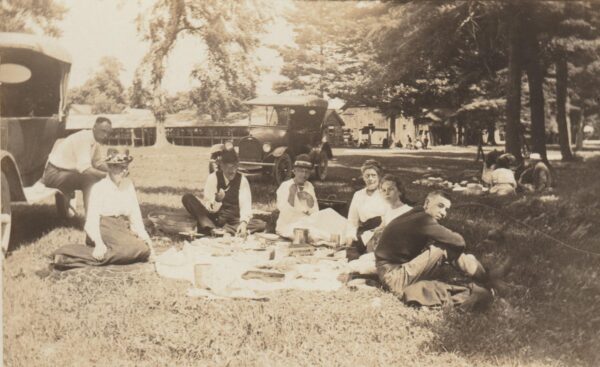Feasting and frolicking: Our picnicking past

Seven years ago in these pages, I described a Civic Holiday excursion to Haliburton that was organized in 1931 under the auspices of the Lindsay Rotary Club. That event, which attracted more than 400 people, was just one in a long line of large local picnics that made the news in tantalizing detail.
“The history of picnics is essentially the history of humankind,” notes culinary historian Lindy Mechefske in her 2021 book, Ontario Picnics: A Century of Dining Outdoors. “We began by eating outside. We have, in a sense, been picnicking forever.” Still, a combination of factors – including transportation technology such as passenger rail service, and the cultural prominence of churches and civic organizations – ensured that picnics would enjoy something of a heyday in the 20th century.
Foremost among these were the picnics organized by local churches, either for their Sunday schools or for the congregation at large. Often one of the Trent Valley Navigation Co. steamboats would be chartered to ferry throngs of picnickers up to the shores of Balsam, Sturgeon, or Pigeon Lakes; in other cases, a nearby grove or park would suffice for the festivities.
Such was the case for the community of Bethel (located northeast of Omemee) in June of 1909, when parishioners at its Methodist church assembled just west of the building for a picnic that saw the young and young-at-heart flitting about, playing catch, enjoying a set of swings, and indulging in ice cream. “About four o’clock, supper commenced. And such suppers!” gushed a participant who described the day for the Watchman-Warder newspaper. “Why, if we had not had to sit on the grass we would have imagined we were dining at the King Edward Hotel in Toronto.”
Nearly 40 years after that event, the various Protestant churches in Lindsay teamed up to plan an enormous picnicking jaunt to Orillia. On June 29, 1948, the Canadian National Railway coupled nine coaches to one of its steam locomotives and highballed towards Couchiching Beach Park for a picnic that reportedly attracted over 900 people. These “picnic specials” ran for a few years and would usually leave Lindsay at 10:15 a.m., returning to town by 6:30 in the evening. Fares for the 1950 excursion were priced at $1.55 for adults and 80¢ for children. “The different churches would organize races and games after their picnic lunch, and we had a great time,” recalled the late James Mackey in a 2019 interview. “For many of us, it was our first and only trip on a train.”

the 1920s. These gradually supplanted old-fashioned picnic
baskets as the automobile gained popularity a century ago.
Perhaps the most famous examples of church-run picnics in what is now Kawartha Lakes were those organized by Knox Presbyterian Church in Glenarm. They began around 1885 and within 30 years were a going concern; over 1,500 people from across the county were said to have attended the picnic in 1908. Generous helpings of potato salad and ham were the order of the day, and it was not uncommon for the ladies of Knox to bake up to a dozen pies each for these events.
Picnics were also organized by political parties and industrial concerns. The United Farmers of Ontario, which enjoyed considerable influence in provincial politics during the early 1920s, held a picnic at Birch Point in Fenelon Township on July 30, 1924. A procession of buggies and cars brought men, women, and children to the grounds where they opened their picnic baskets as games of baseball got underway nearby. This monster picnic was in part meant to rally U.F.O. supporters throughout Victoria County in the face of devastating election losses the year before.
Fostering goodwill among the rank-and-file, whether they be supporters of a political movement or workers in a factory, had long been part of the picnic tradition in this part of Ontario and elsewhere. The Horn Bros. woollen mill, once one of Lindsay’s leading employers, welcomed its staff to a company picnic at Miners’ Bay in the early summer of 1950 – the first such picnic the firm had organized since the end of the Second World War. Kids received a pair of free tickets with which they could redeem for pop or an ice cream cone, while their parents milled about with other employees before lunch got underway. “Noon saw tablecloths and blankets spread out on the grass and people gathered in groups to settle down to that ever pleasant task of eating,” the Lindsay Daily Post reported. “The air was laden with the scent of baked beans, salads, onions, chicken sandwiches, coffee and what have you.”
Tablecloths and blankets continue to be spread out on the grass to this day – whether at Garnet Graham Park in Fenelon Falls or at Victoria Park in Lindsay, among other places. Still others make use of the many picnic shelters that grace our municipal green spaces. While declining Sunday school attendance has largely rendered the church picnic a thing of the past, and extended essays about company picnics in the local press now seem quaint, there can be no question that this tradition remains very much alive. “All picnics have one thing in common,” writes Mechefske, the culinary historian: “that critical, fundamental, all-important connection between land, food, and people.”
So with that in mind, will you please pass me the potato salad? I’m getting hungry.





